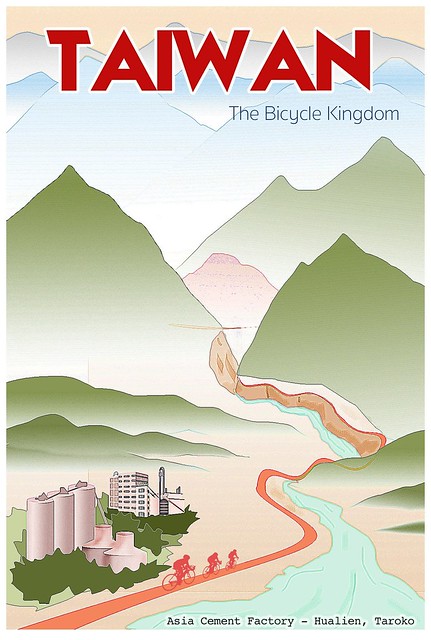
With the annual bicycle festival right around the corner, the Tourism Bureau is again hard at work pumping Taiwan's place in the bicycling universe with lofty powder-puff pay for play articles that seek to lure potential cycling tourists to our shores in search of a life of exotic adventure in the timeless swirling mists of the Far-East.
By the beginning of October the official Tourism Bureau budget is ripe enough to fete cycling writers and bloggers on managed tours of Taiwan's hand picked cycling monuments, which all seem to rest amid the swelling bosom of tourism furniture-- hotels, hot springs, knick knacks, food...etc...or they serve to validate government expenditures on infrastructure like meandering bike paths or bike-share programs that mainly cater to students. The copy retains a familiar form along the official Tourism Bureau talking points listed for each writer to earn airfare and a travel stipend. We see glowing reviews of "the Bicycle Paradise" or the cute moniker "the Cycling Kingdom" with its knowing wink to King Liu the figurehead of Giant Manufacturing Co, Ltd. the maker of several branded bicycles and components.
Take these examples:
"...majestic mountains, scenic cliffs, awe-inspiring waterfalls, quaint peaceful lagoons and all the while being surrounded by water on all sides. Taiwan is really an enchanting tropical paradise to go seeking adventure
Combined with the country’s natural splendor with advance infrastructure i.e. good roads, Taiwan makes an ideal destination for cycling. Due to its vast infrastructure budget spent by the government for the maintenance of its roads, Taiwan altogether has over 3,000 kilometers of road network making it a paradise for cycling enthusiasts to venture within." --Arabian Gazette..................
"Over the last two decades, Taiwan has transformed into a cyclist's paradise, opening thousands of kilometers of interwoven bikeways through some of the island's most beautiful landscapes. The extensive new network of routes has earned the country many accolades, including a spot on Lonely Planet's 2012 Best Countries to Visit list and CNN Travel's top "Cycling Routes That'll Take Your Breath Away," and for good reason. By bike, visitors can cruise past hillsides painted with colorful flower farms, marvel at the geology of Taroko Gorge's marble walls, follow old rail lines through retired mining tunnels, cross thrill-inducing suspension bridges and sample sweet pineapple cakes from local farm stands."--Smithsonian
...................
"Premier Mao stated that he envisions Taiwan becoming a “cycling paradise,” and relevant strategies are necessary to achieve this vision". --Executive Yuan (2015)
...................
"Taiwan is considered by many to be a cyclist’s paradise with its picturesque bike trails through the island-nation’s awe-inspiring scenery. Thanks to extensive funding in the past decade, Taiwan now boasts thousands of miles of bike roads that wrap around the 14,000 square-mile island. The country’s bike paths show off the country’s diverse topography, from plains on the Eastern Coast to Mountains that are at 3,275 altitudes. The breathtaking lush green mountains and beautiful water scenery make your biking adventures heavenly".--Student Universe

The leading culprit in ruining the Taiwan cycling experience is the pernicious air quality. There is no way to escape it. I might lose more than a month of riding each year due to air quality. During the dry winter months the air can be especially noxious.
In a recent article Taichung City Mayor, Lin Chia-lung states his strong support for cycling as an integral part of the central city's identity with a commitment to cycling infrastructure.
Mayor Lin indicated that cycling enthusiasts are in for a treat, as the festival features exciting events including Giant Cup, Taichung Cycling Tour and Wheels Ride Festival Taiwan, encompassing activities such as self-challenges and family cycling recreation. Moreover, the century-old Tour de France will be hosting the L’Etape du tour” in Taiwan for the first time on September 17, making cycling an integral element of Taichung City’s brand. The city government strives to expand city diplomacy and forge sister city ties by continuing to create cycling-friendly environments and fostering the cycling movement.This is one face of Lin Chia-lung. The other is of a glad-handing politician eager to garner support from the industrial sector in his bid to woo industrial production facilities to Taichung and push Taichung further over the threshold as Taiwan's second largest metropolitan area.
According to him, Taichung is the primary industry cluster of cycling; aside from the headquarters of Giant, the city also features popular tourist recreational bikeways in Houfeng, Dongfeng and Tanyashen. The city government is promoting the “Cycling 369” program to establish 300 iBike rental stations, 600km of bikeway and 9,000 iBikes. Furthermore, the “OK Taiwan – Departing from Taichung” round-the-island cycling tour will be launched to promote cycling activities and industry to domestic and overseas markets.--Taichung City Government
In addition, Mayor Lin made some noises last April to the tune of reducing pollutants by 40%.
In an exclusive interview conducted by “YAHOO TV! Weather Risk” at the Taichung City Government Building, Mayor Lin suggested that the air quality of Taichung has been improving in the last 5 years. The content of PM2.5 was 22.8μg/m3 last year in average, which was a decrease of almost 40% from the level of 35μg/m3 in 2011. There are several sources of pollution, including the exhaust from motor vehicles, carbon black from kitchens, uncovered construction work sites, or open-air combustion in addition to the emissions from power generators.--Taichung City GovernmentA problem with these claims is that they rely on Taiwan's EPA, which has long been rumored to be in the pocket of industry and politicians. Polluters are even allowed to report their own numbers. Even the scale of measurement was adjusted to suit Taiwan's higher levels of pollution.
In a piece I wish I had written myself, blogger Michael Turton from The View from Taiwan outlines why Mayor Lin may be just paying lip service to the environment.
The midnight spike in air pollution, using the app airvisual. This is from the Taichung area. The app usually shows a spike, a small one, between midnight and 2 AM. Why? Because factories in Taichung are quietly dumping pollution into the air in the wee hours to avoid EPA fines. I've come to dread Sunday nights because the factories on the hill below our house frequently dump foul-smelling shit into the air.Turton's speculation is supported by the data. It appears factories and the infamous coal-fired power plant in Longjing spend the wee hours ferociously pumping out pollution that often lingers around the Taichung Basin throughout the day before wafting southward. The thought may be that people are either sleeping or indoors working while the pollution levels spike.
In a 2015 report on the impact of air pollutant on human physiology, National Taiwan University released the following report and recommendation:
Upon studying the physiological effects of particulate matter among laboratory rats, Prof. Tsun-Jen Cheng (鄭尊仁) found that fine and ultrafine particles cause damage to the respiratory system upon entrance into the lungs. Affecting the coronary artery and the autonomy of the nervous system, fine particles may lead to the onset of arrhythmia and heart attacks.
Prof. Ta-Chen Su (蘇大成) also discovered that the incidence of cardiovascular inflammation in the blood is related to the inhalation of fine particles. For instance, epidemiological statistics show that the sudden hike in hospitalization for cerebrovascular disease during the winter coincides with short-term increase of air pollutant levels. Statistics also show that the severity of Taipei’s City’s air pollution is highly linked to the thickness of the internal carotid artery, making levels of PM2.5 an important indicator for studying long-term atherosclerosis. Su’s study also suggests that exposure to PM2.5 is detrimental to the development of the infant’s nervous system.
Vice-Dean Chan further noted that Taiwan’s annual PM2.5 standard of 15 µg/m3established by the United States, it is also much higher than the WHO suggested concentration of 10 µg/m3 . Traffic is the major source of air pollutants in Taipei, whereas in Central Taiwan, fine particles are produced primarily by thermal power plants. Urging authorities to take more proactive actions against air pollution, Chan emphasized the importance of setting emission standards according to the human capacity instead of industrial development. Prioritizing health over development, emission standards should be set by the Environmental Protection Administration in conjunction with the Ministry of Health and Welfare, and not, as in the present, with the Ministry of Economy.It is a sad irony that a country that so badly wants to be taken seriously as a "paradise"... enough to make such grand and public proclamations of the sort... can be simultaneously working so hard to hinder positive development in realizing the cycling fantasy. Air pollution can be hard for a cyclist to escape. Even from the highest peaks the views that memories are made of are often obscured by a yellow-white haze. Nobody should be expected to come to Taiwan and enjoy cycling through Venus.
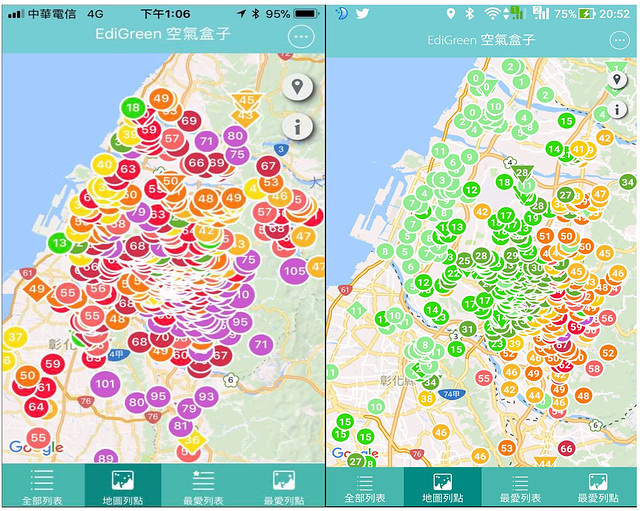
It is not only the air that interferes with Taiwan's desire to become a cycling paradise. Too often unchecked and unregulated development in sensitive natural ands ecological areas serve as a regular reminder to visitors of the blight of concrete and development. The shell of the nearly complete but wholly illegal Miramar Resort in Taidong is the perfect poster child of overdevelopment. Another shameful monument to industrial blight is the Asia Cement Factory near the mouth of the famed Taroko Gorge on Taiwan's east coast. Taroko Gorge is the natural monument that frames Taiwan's KOM Challenge, the world renowned one-day cycling race from the ocean to 3275m. Not only is the Asia Cement Factory and mining operation an eyesore in a sensitive area, it was also built on a site that was procured through deceptive and illegal means.
A fantastic paper, Making Indigenous Lands into ‘concrete’: land grabbing in the embededness of cement industry in Taroko area, Eastern Taiwan by Yung-ching Lo 羅永清 concludes:
Taiwan experienced rapid economic development in the 1970s and 1980s and it inspired an entire development discourse on the ‘Taiwanese miracle’ (Simon 2002). As Simon’s article ‘The Underside of a Miracle: Industrialization, Land, and Taiwan's Indigenous Peoples’ has pointedThese factors place an enormous weight on the ethnical shoulders of a visiting cyclist. As the cycling world converges on Taroko to close out Taiwan's international cycling season this October 20th, with some of the biggest names in the sport attending, they will not only be faced with Taiwan's immediate beauty and serious climbs, but they will also see the cost of the Taiwan industrial state apparatus.
22
out, this view overlooked three important facts that should be taken into account when examining the development in Taiwan. First: rapid development was made possible largely by an oppressive regime of martial law that quelled worker unrest. Second: development took place at immense social and environmental costs. And finally, those costs have been disproportionately borne by Taiwan’s indigenous peoples.
It is with these thoughts in mind that I produced the protest postcards below. They are a reminder of the gulf between our reality and our fantasy as a cycling paradise. Too much work needs to be done before our officials and representatives can even begin to stake authentic claims to "a cycling paradise". The pressure to change needs to remain constant, even on days when the air clears. This is not how I want Taiwan to be remembered.
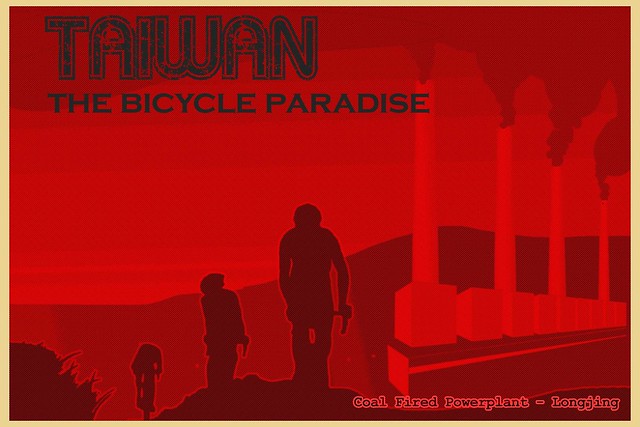
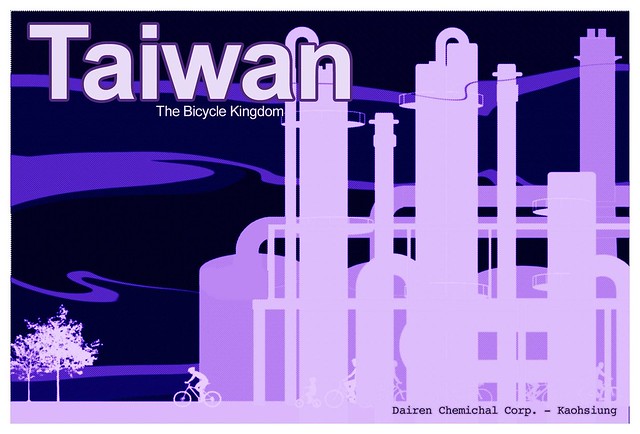
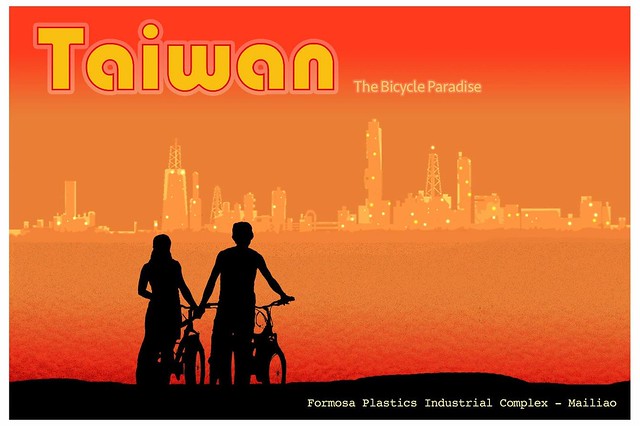
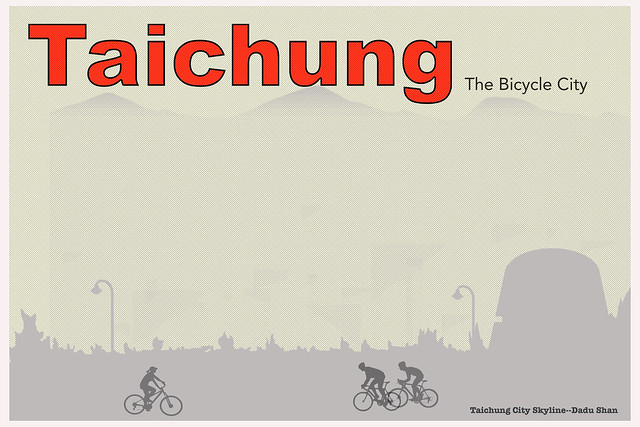

I have refused to attend the Taichung Bike Week dinner next week in order to safe the mayor from a blistering dressing down in the failure to control pollution in Taichung. Even yesterday I was being begged to show up and give a short speach. The last thing Mayor Lin wants is me on a stage in front of the worlds bicycle press reaming a second arsehole into him. Maybe you can take my place.
ReplyDelete雖然我是個美國人,要寫中文談論。我住在台灣三年多,騎單車到好多的風景。台灣真的很美麗啊!這個國家非常安全、人好熱情、生活的壓力比較少。不過,我認為台灣的污染是我們最大的問題。高雄、台南、台中的路況風情很好,但是空氣很差。情況好可憐。人不要賠本,就很快願意帶口罩。
ReplyDeleteThere is a lot to like, but when the air is too dangerous to spend any length of time outside it all remains out of reach.
ReplyDeleteI used to check the weather report before going out l. Now I plan my rides around pollution patterns.
Moreover, if Taipei experienced the air problems the west coast experienced, something would be done.
ReplyDeleteIt fits the old colonial pattern where the rest of Taiwan makes the sacrifices for Taipei.
In Taipei they'll tell you the pollution comes from China. It's never a local problem.
ReplyDeleteThey say that in Kaohsiung too :( heads in the sand
DeleteFact check:
ReplyDeleteplease google: why air pollution increases at night
You will see that it is quite normal that pollution levels are higher at night.
Think of it like hiding under your blanket and keep farting.
I suspect the good (dry) weather in Taichung is not helping in this regard.
BTW The Longjin pp runs on coal. Those things usually keep running full power all day and night. And therefore does not wait until the wee hours, but belches as much pollution any time of the day. What might be interesting to investigate is to see what industries will use the cheap electricity at night because of this set up (same applies to the nukes). Although, the arc furnaces should be not too polluting. Mmm...
Also, you can go to the Longjin powerplant and have them explain stuff to you. Best you give them a call in advance although I just dropped in one day (was a while back).
You are not exactly correct. The Longjing plant is designed for daily and managed start up and shut down of some or all furnaces.
ReplyDeleteIt is one part of the problem. Yes, industry takes advantage at night. The cooler air doesn't help.